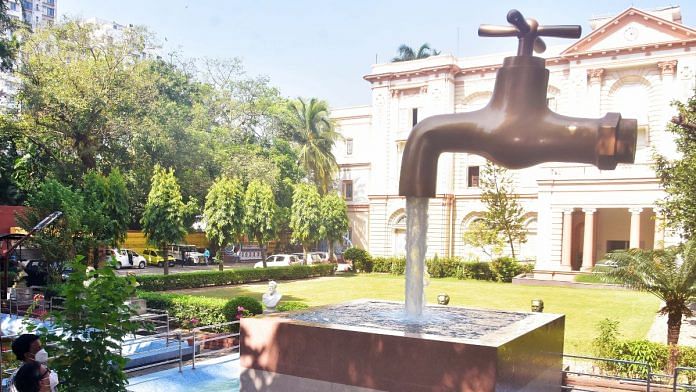New Delhi: First it was slowed down by the pandemic, and now the Russian invasion of Ukraine is threatening to derail the 2024 completion deadline of Nal Se Jal, a flagship scheme of the Modi government to provide potable drinking water to rural households across the country.
This scheme involves creating water supply infrastructure, such as laying pipelines to provide functional tap connections to beneficiary households, besides upgrading existing water supply systems.
The Russia-Ukraine war, which has disrupted trade globally, has resulted in a sharp increase in the prices of two key raw materials used in the manufacturing of pipes — petrochemicals and steel — senior officials in the Union Jal Shakti Ministry’s Department of Drinking Water and Sanitation (DDWS), which is piloting the Nal Se Jal scheme, told ThePrint.
The surge in the prices of raw materials has prompted plastic manufacturers to raise the prices of PVC (polyvinyl chloride), HDPE (high-density polyethylene), and GI (Galvanized iron) pipes, they added.
Officials also said that while three states and three union territories have achieved 100 per cent coverage, 13 states, including Uttar Pradesh, continue to be a challenge.
“States have been telling us that they either are not getting enough bids from suppliers of PVC, HDPE, and GI pipelines or suppliers are quoting excessively high prices because of the rising cost of steel and petrochemicals. States are finding it difficult to procure pipes at such exorbitant rates,” a senior official of the DDWS told ThePrint.
This has slowed down the implementation of the Nal Se Jal scheme, the official added. “We had barely recovered from the disruption caused by Covid since March 2020 when work came to a standstill. Now, it’s the war. It will definitely have a bearing on the timelines, not only this fiscal but the 2024 completion deadline as well,” he said.
However, the official said that the Jal Shakti ministry is holding discussions with states to figure out how to address the delay and expedite the scheme’s implementation. “We are keeping our fingers crossed and hoping that there are no further disruptions,” the official told ThePrint.
Also Read: This paddy cultivation technique is Punjab govt’s answer to ‘save water, avoid crisis’
13 states account for 95% of pending work
The Nal Se Jal programme, launched in August 2019, has a total outlay of Rs 3.60 lakh crore of which the Centre’s share is Rs 2.08 lakh crore. The remaining Rs 1.52 lakh crore has to be borne by the states.
When the scheme was launched in 2019, only 3.23 crore (17 per cent) of 19.22 crore rural households had tap water connections, according to government data. The ministry’s target is to cover the remaining 16 crore (83 per cent) households by 2024.
Jal Shakti Ministry officials said that 100 per cent of households in Goa, Telangana, Haryana, Puducherry, Dadra and Nagar Haveli, Daman and Diu, and the Andaman and Nicobar Islands now have tap water connections.
The challenge, they said, lies with 13 states, where 95 per cent of the work is pending. On the top of this list is Uttar Pradesh, where only 13.83 per cent of households have a running supply of tap water.
Other states affected by the delay include Andhra Pradesh, Karnataka, West Bengal, Madhya Pradesh, Maharashtra, Odisha, Rajasthan, Chhattisgarh, and Jharkhand, among others.
“We are focusing on UP now where there is considerable delay. It’s the largest state and any delay in implementation will have a bearing on the overall target. Regular meetings are held with state officials to expedite implementation,” a senior official in the Jal Shakti Ministry said.
“Soon after the Nal Se Jal scheme was launched, work stalled because of Covid. Then elections were announced and code of conduct was enforced. No work could happen during that time. But the Uttar Pradesh government is now awarding work in drought-prone Bundelkhand and other areas,” the official added.
Besides UP, the Jal Shakti Ministry is also concerned about pockets in Rajasthan, Karnataka, and Madhya Pradesh, where the availability of potable water continues to be a fundamental issue.
“Until inter-basin transfer of water happens here, these three states won’t be able to meet the Jal Jeevan Mission target to provide 55 lpcd (litres per capita per day) water to every household,” an official told ThePrint.
Officials said regular meetings are being held with representatives of the three states to figure out how to make water available in areas where there is a scarcity.
(Edited by Amrtansh Arora)
Also Read: Strict deadlines, amnesty, new developers — Uddhav govt’s plan to speed Mumbai’s slum projects



